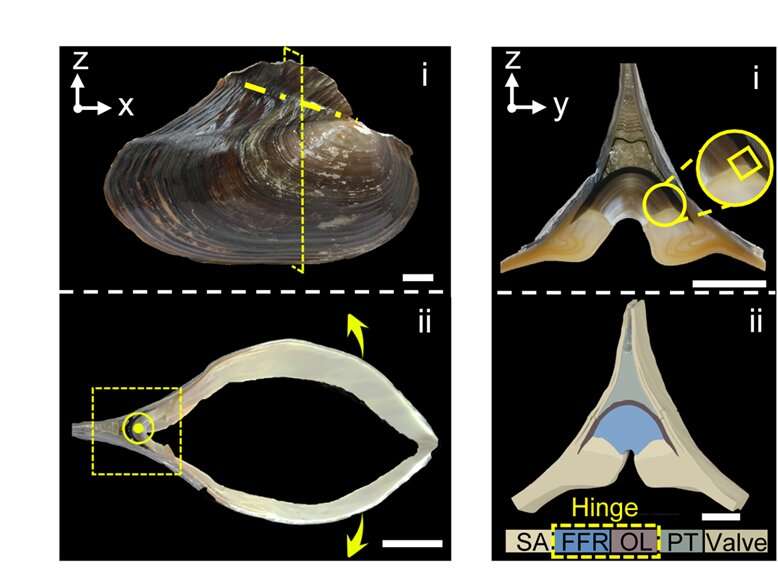This article has been reviewed according to Science X's editorial process and policies. Editors have highlighted the following attributes while ensuring the content's credibility:
fact-checked
peer-reviewed publication
proofread
Scientists learn about fatigue resistance of materials from bivalve hinge

Recently, flexible and foldable devices have developed at a dramatic rate. More and more foldable devices appear in people's lives. Long-term service requires the folded parts to endure repeated deformation which might cause fatigue damage to the devices. Consequently, the damage will affect the normal function of the devices.
Inspired by the hinge of bivalve Cristaria plicata, which experiences hundreds of thousands of repeating opening-and-closing valve motions throughout the bivalve's lifetime, a research team led by Prof. Yu Shuhong collaborating with Prof. Wu Hengan from the University of Science and Technology of China (USTC) proposed their tactics to improve the fatigue resistance of structural materials. The work titled "Deformable hard tissue with high fatigue resistance in the hinge of bivalve Cristaria plicata" was published in Science on 23 June 2023.
The researchers illuminated the mechanism of fatigue resistance of deformable biomineral tissue in the hinge of bivalve C. plicata, a species of mollusk, and proposed a novel design strategy of fatigue-resistant structural materials by exploiting the inherent properties of each component through the multiscale structure.
They found that the folding fan-shaped region (FFR) in the hinge can sustain large deformation during repetitive opening-and-closing valve motions and maintain its structure and function for a long period. The tissue still functions well and shows no signs of fatigue behaviors even after 1,500,000 cycles.
The hinge is composed of two regions, the outer ligament (OL) and the folding fan-shaped region. Through observation and finite element analysis, the researchers uncovered the roles of each hinge region during the valves' motion. When closing, the stretched OL undertakes the circumferential stress dominantly and stores most of the elastic strain energy, while the FFR is deformed circumferentially and provides strong radial support to fix the OL under the limited radial deformation.
They revealed that the hierarchical structures which span from the macroscale level down to the lattice level endow the FFR with notable deformability and load translation capability.
This work provides a novel biomimetic model for designing artificial materials with brittle components and brings a new perspective for elongating materials' longevity. The multi-level design strategy sheds light on development of the future fatigue-resistant materials.
More information: Xiang-Sen Meng et al, Deformable hard tissue with high fatigue resistance in the hinge of bivalve Cristaria plicata, Science (2023). DOI: 10.1126/science.ade2038. www.science.org/doi/10.1126/science.ade2038
Journal information: Science
Provided by University of Science and Technology of China




















